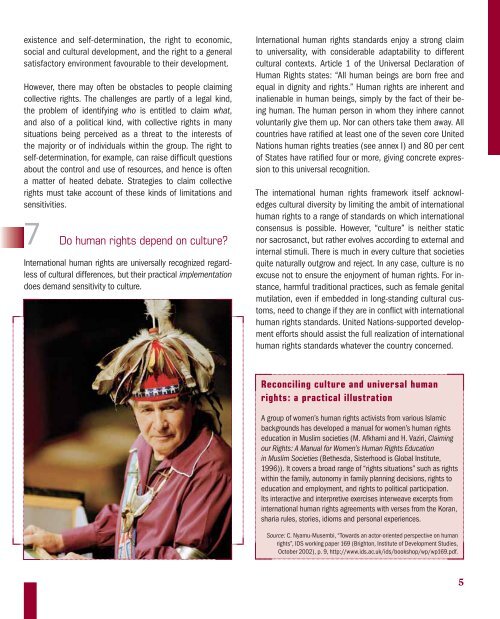Frequently Asked Questions on Human Rights-Based Approach
Frequently Asked Questions on Human Rights-Based Approach
Frequently Asked Questions on Human Rights-Based Approach
- No tags were found...
Create successful ePaper yourself
Turn your PDF publications into a flip-book with our unique Google optimized e-Paper software.
existence and self-determinati<strong>on</strong>, the right to ec<strong>on</strong>omic,social and cultural development, and the right to a generalsatisfactory envir<strong>on</strong>ment favourable to their development.However, there may often be obstacles to people claimingcollective rights. The challenges are partly of a legal kind,the problem of identifying who is entitled to claim what,and also of a political kind, with collective rights in manysituati<strong>on</strong>s being perceived as a threat to the interests ofthe majority or of individuals within the group. The right toself-determinati<strong>on</strong>, for example, can raise difficult questi<strong>on</strong>sabout the c<strong>on</strong>trol and use of resources, and hence is oftena matter of heated debate. Strategies to claim collectiverights must take account of these kinds of limitati<strong>on</strong>s andsensitivities.7 Do human rights depend <strong>on</strong> culture?Internati<strong>on</strong>al human rights are universally recognized regardlessof cultural differences, but their practical implementati<strong>on</strong>does demand sensitivity to culture.Internati<strong>on</strong>al human rights standards enjoy a str<strong>on</strong>g claimto universality, with c<strong>on</strong>siderable adaptability to differentcultural c<strong>on</strong>texts. Article 1 of the Universal Declarati<strong>on</strong> of<strong>Human</strong> <strong>Rights</strong> states: “All human beings are born free andequal in dignity and rights.” <strong>Human</strong> rights are inherent andinalienable in human beings, simply by the fact of their beinghuman. The human pers<strong>on</strong> in whom they inhere cannotvoluntarily give them up. Nor can others take them away. Allcountries have ratified at least <strong>on</strong>e of the seven core UnitedNati<strong>on</strong>s human rights treaties (see annex I) and 80 per centof States have ratified four or more, giving c<strong>on</strong>crete expressi<strong>on</strong>to this universal recogniti<strong>on</strong>.The internati<strong>on</strong>al human rights framework itself acknowledgescultural diversity by limiting the ambit of internati<strong>on</strong>alhuman rights to a range of standards <strong>on</strong> which internati<strong>on</strong>alc<strong>on</strong>sensus is possible. However, “culture” is neither staticnor sacrosanct, but rather evolves according to external andinternal stimuli. There is much in every culture that societiesquite naturally outgrow and reject. In any case, culture is noexcuse not to ensure the enjoyment of human rights. For instance,harmful traditi<strong>on</strong>al practices, such as female genitalmutilati<strong>on</strong>, even if embedded in l<strong>on</strong>g-standing cultural customs,need to change if they are in c<strong>on</strong>flict with internati<strong>on</strong>alhuman rights standards. United Nati<strong>on</strong>s-supported developmentefforts should assist the full realizati<strong>on</strong> of internati<strong>on</strong>alhuman rights standards whatever the country c<strong>on</strong>cerned.Rec<strong>on</strong>ciling culture and universal humanrights: a practical illustrati<strong>on</strong>A group of women’s human rights activists from various Islamicbackgrounds has developed a manual for women’s human rightseducati<strong>on</strong> in Muslim societies (M. Afkhami and H. Vaziri, Claimingour <strong>Rights</strong>: A Manual for Women’s <strong>Human</strong> <strong>Rights</strong> Educati<strong>on</strong>in Muslim Societies (Bethesda, Sisterhood is Global Institute,1996)). It covers a broad range of “rights situati<strong>on</strong>s” such as rightswithin the family, aut<strong>on</strong>omy in family planning decisi<strong>on</strong>s, rights toeducati<strong>on</strong> and employment, and rights to political participati<strong>on</strong>.Its interactive and interpretive exercises interweave excerpts frominternati<strong>on</strong>al human rights agreements with verses from the Koran,sharia rules, stories, idioms and pers<strong>on</strong>al experiences.Source: C. Nyamu-Musembi, “Towards an actor-oriented perspective <strong>on</strong> humanrights”, IDS working paper 169 (Bright<strong>on</strong>, Institute of Development Studies,October 2002), p. 9, http://www.ids.ac.uk/ids/bookshop/wp/wp169.pdf.5
















